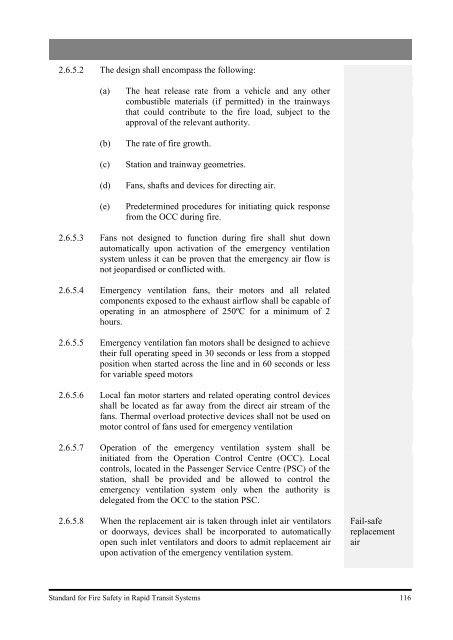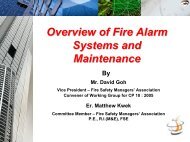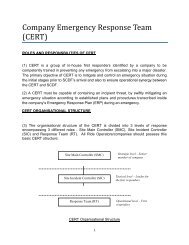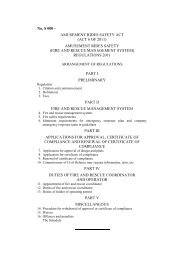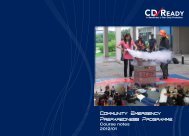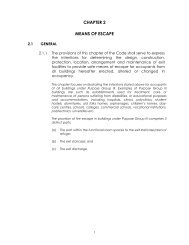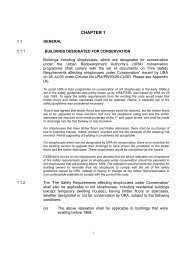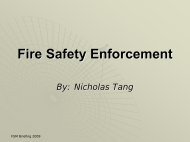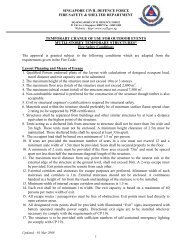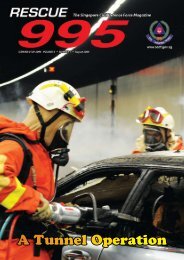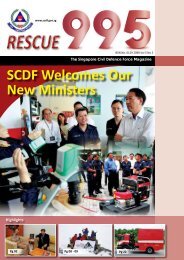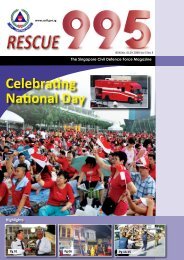Standard for Fire Safety in Rapid Transit Systems - Singapore Civil ...
Standard for Fire Safety in Rapid Transit Systems - Singapore Civil ...
Standard for Fire Safety in Rapid Transit Systems - Singapore Civil ...
You also want an ePaper? Increase the reach of your titles
YUMPU automatically turns print PDFs into web optimized ePapers that Google loves.
2.6.5.2 The design shall encompass the follow<strong>in</strong>g:<br />
(a) The heat release rate from a vehicle and any other<br />
combustible materials (if permitted) <strong>in</strong> the tra<strong>in</strong>ways<br />
that could contribute to the fire load, subject to the<br />
approval of the relevant authority.<br />
(b) The rate of fire growth.<br />
(c) Station and tra<strong>in</strong>way geometries.<br />
(d) Fans, shafts and devices <strong>for</strong> direct<strong>in</strong>g air.<br />
(e) Predeterm<strong>in</strong>ed procedures <strong>for</strong> <strong>in</strong>itiat<strong>in</strong>g quick response<br />
from the OCC dur<strong>in</strong>g fire.<br />
2.6.5.3 Fans not designed to function dur<strong>in</strong>g fire shall shut down<br />
automatically upon activation of the emergency ventilation<br />
system unless it can be proven that the emergency air flow is<br />
not jeopardised or conflicted with.<br />
2.6.5.4 Emergency ventilation fans, their motors and all related<br />
components exposed to the exhaust airflow shall be capable of<br />
operat<strong>in</strong>g <strong>in</strong> an atmosphere of 250ºC <strong>for</strong> a m<strong>in</strong>imum of 2<br />
hours.<br />
2.6.5.5 Emergency ventilation fan motors shall be designed to achieve<br />
their full operat<strong>in</strong>g speed <strong>in</strong> 30 seconds or less from a stopped<br />
position when started across the l<strong>in</strong>e and <strong>in</strong> 60 seconds or less<br />
<strong>for</strong> variable speed motors<br />
2.6.5.6 Local fan motor starters and related operat<strong>in</strong>g control devices<br />
shall be located as far away from the direct air stream of the<br />
fans. Thermal overload protective devices shall not be used on<br />
motor control of fans used <strong>for</strong> emergency ventilation<br />
2.6.5.7 Operation of the emergency ventilation system shall be<br />
<strong>in</strong>itiated from the Operation Control Centre (OCC). Local<br />
controls, located <strong>in</strong> the Passenger Service Centre (PSC) of the<br />
station, shall be provided and be allowed to control the<br />
emergency ventilation system only when the authority is<br />
delegated from the OCC to the station PSC.<br />
2.6.5.8 When the replacement air is taken through <strong>in</strong>let air ventilators<br />
or doorways, devices shall be <strong>in</strong>corporated to automatically<br />
open such <strong>in</strong>let ventilators and doors to admit replacement air<br />
upon activation of the emergency ventilation system.<br />
Fail-safe<br />
replacement<br />
air<br />
<strong>Standard</strong> <strong>for</strong> <strong>Fire</strong> <strong>Safety</strong> <strong>in</strong> <strong>Rapid</strong> <strong>Transit</strong> <strong>Systems</strong> 116


